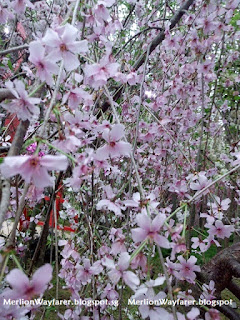Gardens By The Bay
Marina, South
March 2016
Fascinated by the "sakura fever", Merlion Wayfarer delves into cyberspace and digs out some essential nuggets about sakura blossoms...
Sakura
Cherry blossom is known as "sakura" in Japanese, and it is the country’s national flower. A symbol of renewal and hope, cherry blossom heralds the arrival of spring each year, and it can be seen in abundance from late March to mid-April.
Sakura Zensen
The Japanese have a television forecast for cherry blossom season, provided by the country’s Meteorological Agency. It is based on the sample trees planted in the different regions of Japan. The blossom moves north in a "sakura zensen", or cherry blossom front, and its progress is keenly tracked.
Cherry Blossom Capital
Surprisingly, the title of "Cherry Blossom Capital of the World" isn’t actually bestowed on a Japanese city. That honour falls to Macon, in Georgia, USA, which is home to an estimated 300,000 sakura trees.
Yoshino Cherry Tree
The Prunus × yedoensis, or Yoshino cherry tree, is the type of cherry blossom tree most often seen in Japan, but did you know that it is a hybrid? Unable to reproduce naturally, they are treated with great care by their cultivators so they produce splendid blossoms year after year. Japan is home to over 200 different varieties of cherry blossom, the most popular being the “Somei Yoshino”. Its white flowers have the merest hint of pink and usually last no more than a week - a reminder of the transient nature of life.
Hanami
During cherry blossom season you’ll often see groups of people having picnics underneath the cherry trees. This is called "hanami", or "flower viewing". The tradition of hanami has been going on for many hundreds of years; according to a text from the 8th century, such festivities have been held since at least the 3rd century.
Yozakura
When hanami takes place at night, it’s known as "yozakura", which means "night sakura". On such occasions, paper lanterns are hung in the trees to light up the night.
Cherry Blossom Parties
Hanami festivities are celebrated with gusto, with music, specially prepared dishes of food and sake (rice wine). During cherry blossom season, the parks are alive with the sound of people admiring the flowers and joyfully celebrating.
Cherry blossoms or Peach blossoms?
Cherry Blossoms
- Cherry blossoms have five petals and a small characteristic V-shaped notch at the end of each petal. Even when the flowers are hybrids, they still have that characteristic v-notch centered on the edge.
- The bark of the cherry tree often has small horizontal lines on it.
- More than one cherry will come out of a cherry bud.
- The leaves of cherry trees are green and unfolding.
Plum Blossoms
- Plum blossoms don’t have any split at the end of the petals.
- There is only one plum blossom coming out of the bud.
- Although some varieties of white plum blossoms will have small green leaves, plum blossoms have small purple leaves that are unrolling.
- Plum blossoms have a very fragrant smell (they smell “flowery”).
- The bark on a plum tree is darker and does not have distinctive horizontal lines on it.
This experimental floral display is expected to run till March 27. Check Gardens by the Bay’s Facebook page at www.facebook.com/gardensbythebay for updates on the blooming.
































